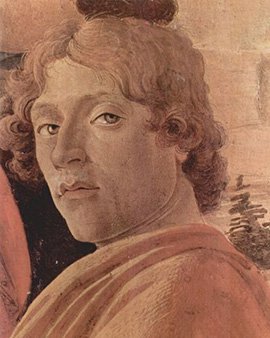"Keg", not necessarily a charming nickname and yet almost every art connoisseur knows it by this name. We are talking about the Italian painter Alessandro di Mariano Filipepi, who celebrated his birthday on 1 March 1445. But the painter is known almost exclusively as Sandro Botticelli. Botticelli counts among the most important Italian painters and draughtsmen of the early Renaissance. The Italian did not come from a family of artists. His father was a tanner in the Florentine working class district of Ognissanti.
Sandro Botticelli was not considered to be particularly industrious at school. For this reason his father decided to send him to his brother Antonio in the goldsmith teachers. Connected to this education he continued his apprenticeship at Filippo Lippi in Prato, where he painted the choir of the cathedral of Prato. Probably further studies with famous Florentine painters such as Antonio Pollaiuolo followed.
and Andrea del Verrocchio
. In the workshop Verrocchio he might have met Leonardo da Vinci who was also working there. At the age of 25, Sandro Botticelli opened his own workshop and in the same year received the commission to paint a picture of courage from Tommaso Soderini. With this work he completed the series of virtues which was produced for the court in Palazzo dei Mercanti. Thanks to the contact with the Medici, and above all to the support of Lorenzi de Medici, the painter enjoyed political protection and numerous public commissions over the next 20 years. Slender female bodies, pale, melancholic faces framed by magnificent golden hair are typical of Botticelli. His work "The Birth of Venus" represents the first almost life-size female nude since antiquity. One year, between 1481 and 1482, Sandro Botticelli stayed in Rome after he was appointed by Pope Sixtus IV. In collaboration with other Italian artists he worked on large murals in the newly built Sistine Chapel. These murals show events from the lives of Jesus and Moses as well as some portraits of former popes.
Among the last paintings of the Italian painter are the works "The Lamentation of Christ" and the "Mystical Birth of Christ". The latter is the only painting by Botticelli that was signed and dated. It was painted in 1501 and in the following years Botticelli did not paint any more, it is assumed that he was unable to paint due to a disability. His workshop, however, continued to work. Nevertheless, in 1504 he was a member of a committee of esteemed artists that decided on the location of Michelangelo's marble statue of "David". Documents describe that the artist was an impoverished man in his old age. On 17 May 1510 Sandro Botticelli found his last rest in the cemetery of the church Ognissanti. He was buried in the same Florentine quarter where he spent most of his life.
×





.jpg)
.jpg)
.jpg)
.jpg)
.jpg)
.jpg)
 - (MeisterDrucke-25084).jpg)
 - (MeisterDrucke-25084).jpg)
 - (MeisterDrucke-604150).jpg)
 - (MeisterDrucke-604150).jpg)
.jpg)
.jpg)
.jpg)
.jpg)
_Botticelli_-_The_Birth_of_Venus_c1485_(tempera_on_canvas)_-_(MeisterDrucke-899818).jpg)
_Botticelli_-_The_Birth_of_Venus_c1485_(tempera_on_canvas)_-_(MeisterDrucke-899818).jpg)
.jpg)
.jpg)
.jpg)
.jpg)
.jpg)
.jpg)
.jpg)
.jpg)
.jpg)
.jpg)
.jpg)
.jpg)
.jpg)
.jpg)
.jpg)
.jpg)
_c_1480-81_-_(MeisterDrucke-317147).jpg)
_c_1480-81_-_(MeisterDrucke-317147).jpg)
.jpg)
.jpg)
.jpg)
.jpg)
.jpg)
.jpg)
.jpg)
.jpg)
.jpg)
.jpg)
.jpg)
.jpg)
_Botticelli_-_The_birth_of_Venus_(detail)_-_(MeisterDrucke-1001780).jpg)
_Botticelli_-_The_birth_of_Venus_(detail)_-_(MeisterDrucke-1001780).jpg)
.jpg)
.jpg)
.jpg)
.jpg)
_Botticelli_-_Autumn_or_allegory_against_wine_abuse_A_young_woman_carrying_on_her_head_a_baske_-_(MeisterDrucke-1002747).jpg)
_Botticelli_-_Autumn_or_allegory_against_wine_abuse_A_young_woman_carrying_on_her_head_a_baske_-_(MeisterDrucke-1002747).jpg)
.jpg)
.jpg)
_-_(MeisterDrucke-390770).jpg)
_-_(MeisterDrucke-390770).jpg)
.jpg)
.jpg)
.jpg)
.jpg)
_-_(MeisterDrucke-36838).jpg)
_-_(MeisterDrucke-36838).jpg)
.jpg)
.jpg)
 - (MeisterDrucke-197791).jpg)
 - (MeisterDrucke-197791).jpg)
.jpg)
.jpg)
_Botticelli_-_The_Adoration_of_the_Magi_Detail_Self-portrait_par_Botticelli_Sandro_(1445-1510)_-_(MeisterDrucke-1028622).jpg)
_Botticelli_-_The_Adoration_of_the_Magi_Detail_Self-portrait_par_Botticelli_Sandro_(1445-1510)_-_(MeisterDrucke-1028622).jpg)
.jpg)
.jpg)
.jpg)
.jpg)
.jpg)
.jpg)
.jpg)
.jpg)
.jpg)
.jpg)
.jpg)
.jpg)
 - (MeisterDrucke-122142).jpg)
 - (MeisterDrucke-122142).jpg)
.jpg)
.jpg)
 - (MeisterDrucke-82232).jpg)
 - (MeisterDrucke-82232).jpg)
_Botticelli_-_Madonna_del_Magnificat_and_five_angels_(tondo)_-_1481-1483_-_(MeisterDrucke-939044).jpg)
_Botticelli_-_Madonna_del_Magnificat_and_five_angels_(tondo)_-_1481-1483_-_(MeisterDrucke-939044).jpg)
_Botticelli_-_Madonna_has_Child_with_Two_Angels_Detrempe_on_Wood_by_Sandro_Filipepi_dit_Bottic_-_(MeisterDrucke-1023527).jpg)
_Botticelli_-_Madonna_has_Child_with_Two_Angels_Detrempe_on_Wood_by_Sandro_Filipepi_dit_Bottic_-_(MeisterDrucke-1023527).jpg)
.jpg)
.jpg)
.jpg)
.jpg)
.jpg)
.jpg)
.jpg)
.jpg)
_-_(MeisterDrucke-875278).jpg)
_-_(MeisterDrucke-875278).jpg)
_Botticelli_-_The_spring_Detail_Zephyr_seizing_Chloris_wearing_a_transparent_veil_(Painting_-_(MeisterDrucke-946468).jpg)
_Botticelli_-_The_spring_Detail_Zephyr_seizing_Chloris_wearing_a_transparent_veil_(Painting_-_(MeisterDrucke-946468).jpg)
.jpg)
.jpg)
.jpg)
.jpg)
_Botticelli_-_Retable_de_Saint-Ambroise_(Saint_Ambroise)_ou_Retable_des_Convers_Detail_de_Sain_-_(MeisterDrucke-1420368).jpg)
_Botticelli_-_Retable_de_Saint-Ambroise_(Saint_Ambroise)_ou_Retable_des_Convers_Detail_de_Sain_-_(MeisterDrucke-1420368).jpg)
.jpg)
.jpg)
.jpg)
.jpg)
.jpg)
.jpg)
 (for detail see 107250) - (MeisterDrucke-191978).jpg)
 (for detail see 107250) - (MeisterDrucke-191978).jpg)
.jpg)
.jpg)
.jpg)
.jpg)
.jpg)
.jpg)
_Botticelli_-_The_face_of_Flora_detail_of_the_allegory_of_spring_c1477-1482_(tempera_on_wood)_-_(MeisterDrucke-1088464).jpg)
_Botticelli_-_The_face_of_Flora_detail_of_the_allegory_of_spring_c1477-1482_(tempera_on_wood)_-_(MeisterDrucke-1088464).jpg)
.jpg)
.jpg)
_Botticelli_-_The_spring_Detail_of_the_Three_Graces_(Painting_-_(MeisterDrucke-1004544).jpg)
_Botticelli_-_The_spring_Detail_of_the_Three_Graces_(Painting_-_(MeisterDrucke-1004544).jpg)
.jpg)
.jpg)
.jpg)
.jpg)
.jpg)
.jpg)
.jpg)
.jpg)
_Botticelli_-_The_birth_of_Venus_(detail)_-_Tempera_on_canvas_-_(MeisterDrucke-1438750).jpg)
_Botticelli_-_The_birth_of_Venus_(detail)_-_Tempera_on_canvas_-_(MeisterDrucke-1438750).jpg)
.jpg)
.jpg)
.jpg)
.jpg)
_Botticelli_-_Venus_and_the_Graces_offering_presents_to_a_young_girl_Fresco_of_Villa_Lemmi_Pai_-_(MeisterDrucke-1029986).jpg)
_Botticelli_-_Venus_and_the_Graces_offering_presents_to_a_young_girl_Fresco_of_Villa_Lemmi_Pai_-_(MeisterDrucke-1029986).jpg)
.jpg)
.jpg)
.jpg)
.jpg)
.jpg)
.jpg)
.jpg)
.jpg)
.jpg)
.jpg)
.jpg)
.jpg)
_-_(MeisterDrucke-310414).jpg)
_-_(MeisterDrucke-310414).jpg)
.jpg)
.jpg)
.jpg)
.jpg)
.jpg)
.jpg)
.jpg)
.jpg)
.jpg)
.jpg)
.jpg)
.jpg)
 (see 412 and 85293) - (MeisterDrucke-95152).jpg)
 (see 412 and 85293) - (MeisterDrucke-95152).jpg)
.jpg)
.jpg)
.jpg)
.jpg)
_Botticelli_-_Madonna_of_the_Magnificat_or_Virgin_with_Child_and_five_angels_(tempera_on_wood_-_(MeisterDrucke-1001615).jpg)
_Botticelli_-_Madonna_of_the_Magnificat_or_Virgin_with_Child_and_five_angels_(tempera_on_wood_-_(MeisterDrucke-1001615).jpg)
_Botticelli_-_Story_of_Nastagio_degli_Onesti_Infernal_Hunt_second_panel_in_a_series_of_four_Na_-_(MeisterDrucke-1030021).jpg)
_Botticelli_-_Story_of_Nastagio_degli_Onesti_Infernal_Hunt_second_panel_in_a_series_of_four_Na_-_(MeisterDrucke-1030021).jpg)
.jpg)
.jpg)
_-_(MeisterDrucke-70911).jpg)
_-_(MeisterDrucke-70911).jpg)
.jpg)
.jpg)
.jpg)
.jpg)
 - (MeisterDrucke-96854).jpg)
 - (MeisterDrucke-96854).jpg)
.jpg)
.jpg)
1489 - (MeisterDrucke-51400).jpg)
1489 - (MeisterDrucke-51400).jpg)
.jpg)
.jpg)






